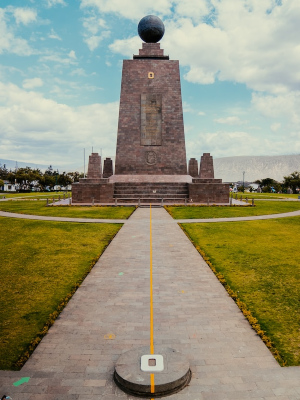
“Shellbacks”, “Polly Wogs” and “Sons of Neptune” – have you ever heard of these names? Two of them are actually “honorary” titles. Although it sounds rather funny, sailors who cross the equator for the first time, the “polly wogs”, earn the title of “shellbacks” because they have proved themselves to be experienced sailors. This is often accompanied by various celebrations to honour the god of the sea, Neptune. The way in which the traditions are held varies, but it is often a fun celebration involving dressing up in costume and performing a play. As you see, the equator seems to be an important reference point with a special meaning – but what is it exactly?
If you imagine drawing a line around the middle of the Earth between the North and South Poles, you have a good idea of what the equator is. It is invisible – but it is marked by some monuments, such as the Monument to the Equator in Ecuador – a country which took its name from this imaginary line. It divides our planet into the southern and northern hemispheres and crosses the land of eleven countries. Read on to find out five interesting facts you maybe didn’t know about the equator.
1. The amount of daylight is always the same.
Because the sun is always at a right angle to the earth at the equator, day and night are always the same length. The sun’s position in relation to the Earth is also the reason why sunrises and sunsets last only a few minutes. So be prepared to be fast if you are on holiday and want to have a nice sunset dinner!
2. The Earth is wider at the equator.
This phenomenon is called the Equatorial Bulge and is caused by the centrifugal force of the Earth as it spins on its axis. This means that you are further away from the centre of the Earth at the equator! Plus, the consequence of this is that if we would measure mountains from the centre of the Earth and not from sea level, then Mount Chimborazo in Ecuador would be the highest place on Earth, not Mount Everest.
3. The equator is the best location to launch rockets.
Space launches usually take place near the equator – but why? The answer has to do with the speed of the Earth’s rotation. While it is about zero at the poles, it is at its highest at the equator: about 1,670 km/h! If you compare this to the speed of a car, it is almost unimaginable. But the consequences are quite useful: The Earth’s gravity does not pull you to the ground so strongly – and rockets get an extra speed boost.
4. You can do winter sports on the equator.
Contrary to what many people think, it can snow on the equator. There are some pretty high mountains where this is possible, for example a volcano in Ecuador. Although the sun is very close to the earth at the equator, it is not the hottest place in the world because it has a very humid climate. The Andes and other mountains are an exception – the Atacama Desert, for example, gets almost no rain all year round! Nevertheless, there are usually two seasons at the equator: the rainy season and the dry season.
5. Almost half of the world’s rainforests can be found on the equator.
Sloths, parrots, frogs – the humid climate creates the perfect environment for many plants and animals to thrive. But you can also see impressive biodiversity in the savannah, where you can meet lions, cheetahs and elephants. Sadly, many of these species are now threatened. The Amazon rainforest, for example, is in danger from deforestation, which is destroying much of the forest and therefore the home of many animals.
The equator is a fascinating, strange and beautiful place on Earth and worth a visit – you are moving faster around the Earth’s axis here (although you probably won’t feel it unless you are about to launch a rocket into space), you can experience very short sunrises and sunsets, you can meet countless different species and even go skiing. Hopefully, you have learnt something new about the invisible line around our planet – and perhaps one day you will be able to “cross the line” by boat, plane or foot and experience some of the facts first hand!
References:
- https://weather.com/science/nature/video/5-fun-facts-about-the-equator – The Weather Channel, 21/01/2020
- https://kids.kiddle.co/Equator – Kiddle encyclopedia, 20/07/2022
- https://education.nationalgeographic.org/resource/equator/ – Jeannie Evers, National Geographic Society, 01/12/2022
- https://eden.uktv.co.uk/nature/earth/article/equator-facts/ – Eden, n.d., accessed 30/3/2023
- https://en.wikipedia.org/wiki/Equator – The Wikipedia Community, 06/03/2023
- https://kidadl.com/facts/amazing-equator-facts-that-would-inflate-your-curiosity – Sridevi Tolety, Kidadl, 23/03/2023

